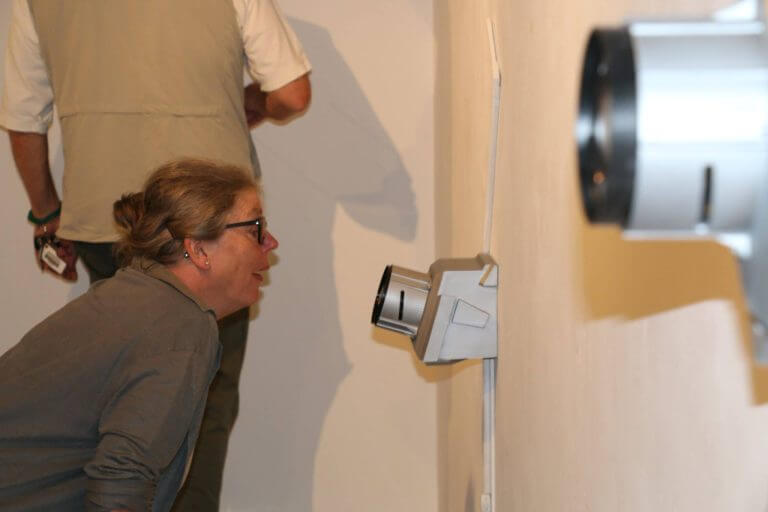Through the Lens, one of the Hunterdon Art Museum’s current exhibitions, highlights the work of artists Lorrie Fredette and Gianluca Bianchino and features site-specific installations inspired by technology and rooted in nature and scientific discovery.
Bianchino’s work investigates physics, particularly as it applies to astronomy, while Fredette is inspired by cellular forms and investigations into viruses and the diseases they cause. Both artists utilize the lens – the microscope or telescope – to reveal the natural world in ways that aren’t visible to the naked eye.
The show is curated by Jeanne Brasile, who is also gallery director of the Walsh Gallery at Seton Hall University. She recently took a few minutes to discuss the exhibition.
Q: How did the idea for bringing these two artists together originally come about?
A: I am a great admirer of both artists, and I have worked with both Gianluca and Lorrie before, though not as a trio, on numerous projects before this. In 2012, I curated a group show entitled Linear Thinking at my home base at Seton Hall University. I am rather sure it was the first time they had been in a show together. I can’t say I had epiphany moment where I thought “I must curate a show with these artists!”, but your question prompted me to think about how it really did come about. I realize it developed liminally, like most of my exhibition themes. During the show at Seton Hall, I recall this image of Gianluca and Lorrie’s work being visually superimposed as I walked the length of the gallery multiple times each day, and I liked that image and the interplay of the work. I also realized that both artists were investigating similar things, but from opposite directions. Gianluca is assembling cosmic expanses, on a miniscule scale. Lorrie is compiling masses of cellular forms magnified tens of thousands of times. I also liked the harmony in their approaches. They build aggregates of forms in a semi-intuitive fashion as a means to explore something we cannot know without science and technology. They are both explorers.

A visitor is astounded when viewing art ‘through the lens.’
Q: With the setting of the Museum being an element in this site specific show, I’m wondering about any unique challenges you might have putting this show in here? (the fact that building is repurposed from a grist mill?
A: The eccentric and historic architecture is one of the most exciting aspects of the show for us. It’s a unique challenge as a curator, and particularly as an artist, to respond to a space with all this history and quirkiness. The building and the residue of its past can activate the art in a completely different way than a white cube space. It’s the element of the unexpected that provides possibilities for new interpretations of the work for me, the artist and the visitor. Gianluca and Lorrie’s process – the workmanlike way they building things, the media they use, intimacy with their materials – parallels the relationship mill workers might have had with their products and raw materials. The show has a holistic quality that is really genuine to us. If you think about it, mills were part of the whole industrial revolution and were cutting edge technology back in the day. Gianluca and Lorrie’s interest in science and technology reflects the contemporary impulse in that direction.
Q: What do you hope viewers will get out of the exhibition after seeing it?
A: Overtly, this show is about how neither Gianluca, nor Lorrie’s work would be possible without developments in the lens. Gianluca often relies on source imagery of galaxies, black holes and other celestial bodies for inspiration. These images are the result of sophisticated telescopes and cameras. Lorrie very often uses images from microscopes as starting point for her work. Situated between these infinite and infinitesimal worlds, we’re hoping the viewer might posit their position in the world they inhabit. It’s much larger and yet, much smaller than we think. Overall, I would like viewers to immerse themselves in this environment and just experience it. I’m not sure I want to dictate a specific experience or idea beyond that. I’m more interested in engagement, and opening possibilities for discussion or thought. One of the best things for a curator is when viewers have their own insights that are valid and often times, brilliant — and not something I necessarily had thought of when working on the show. Once the exhibition is installed, you lose control over its interpretation. It’s out there, and people will think what they’re going to think. I really like that once a show is in the gallery, it no longer really belongs to the artist or curator.
Q: Is there a piece or two in the exhibition that we could highlight in the article that come to mind? What could we tell viewers about it/them?
A: The show is comprised primarily of two large installations that consist of a fair amount of interplay between the artists, the art and the space. Gianluca and Lorrie have been working on new components to expand their repertoires. Lorrie has been making a series of new shapes and sizes of wax “orbs” that will wind around and reside in the various architectural idiosyncrasies in the gallery. Her work is directly tied to the space in that it will also draw viewers’ attention to it as well. Gianluca has made ten new “portals” which contain viewing lenses through which the visitors are transported to another layer of regressive space. There’s this pervading idea of movement and exploration weaving in and out of this exhibition, both physically as well as metaphorically.